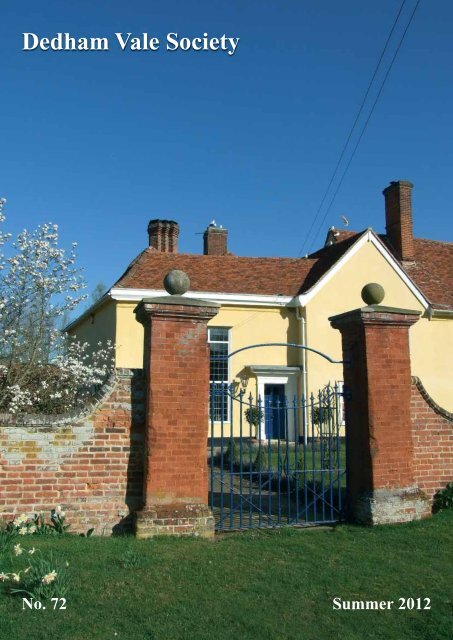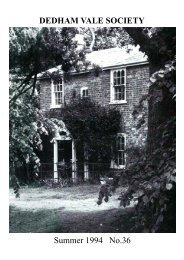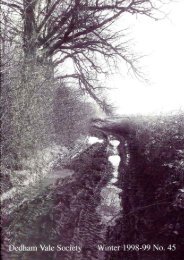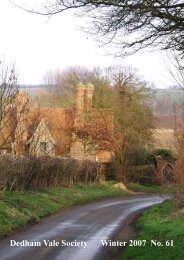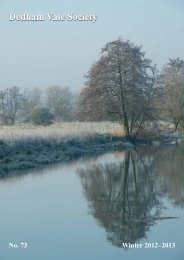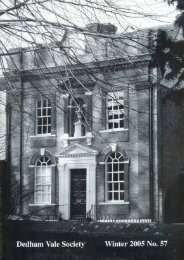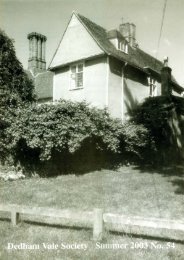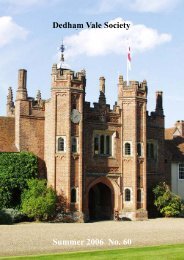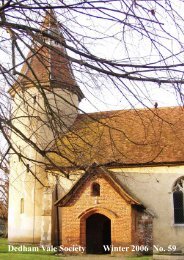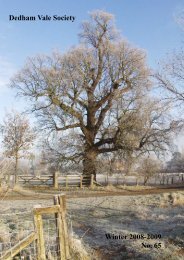Create successful ePaper yourself
Turn your PDF publications into a flip-book with our unique Google optimized e-Paper software.
<strong>Dedham</strong> <strong>Vale</strong> <strong>Society</strong>No. 72 Summer 2012
THE DEDHAM VALE SOCIETYFounded 1938Registered Charity No 246007www.dedhamvalesociety.orgPRESIDENTRobert Erith TD DLHONORARY VICE PRESIDENTAnn TolhurstCHAIRMANCharles CloverHONORARY SECRETARYSarah CarrGulson’s FarmBoxted Church StreetCOLCHESTER C04 5SX01206 272207mrscarr@btinternet.comHONORARY TREASURERAdam SedgwickThe Downs HouseStoke by NaylandCOLCHESTER C06 4QR01206 262437adam.sedgwick@which.netMEMBERSHIP SECRETARYJohn OsbornRose House, Link LaneBentleyIPSWICH IP9 2DP01473 313111johnfosborn@btinternet.comPLANNING SECRETARY, ESSEXRoger DruryWorkhouse CottagesWorkhouse Lane, Little HorkesleyCOLCHESTER CO6 4DS01206 271454roger.drury@btinternet.comPLANNING SECRETARY, SUFFOLKAND NEWSLETTER EDITORDavid EkingFarthings, Thorington StreetStoke by NaylandCOLCHESTER CO6 4SP01206 337477david.eking@btinternet.comARCHITECTURAL ADVISERQuinlan Terry01206 337209COMMITTEEMichael Archer 01206 322169 mlarcher@btinternet.comPaul Gallifant 01206 394202 p.gallifant@btinternet.comNella Probert 01787 227237 nellaprobert@hotmail.comWill Sambrook 01284 830829 will@akenham.comFrancis Terry 01206 577895 francis@qftarchitects.comCOMMITTEE REPRESENTATIVES FROMOTHER GROUPSCharles Aldous (Colne Stour Countryside Assn)01787 227881 charles.aldous@btinternet.comRosemary Turner (CPREssex)01376 563810 romacturner@aol.comEDITION NO 72CONTENTSThe President’s Comments 3From the Chairman 3A Prospect of Pylons 4Essex Planning Note 7Iris Westwood 8Suffolk Planning Note 10“Stour Valley Visitor Centre” 11EDITORIALI am delighted to report that my comment last time that itwas becoming questionable whether the <strong>Society</strong> couldcontinue to afford two full colour A4 editions of theMagazine annually produced a most generous reaction froma member who enclosed a cheque for £500 accompanied bya plea to keep it as it is. We will do our best!This edition focuses particularly on National Grid’sproposed route for the new line of pylons from Bramfordto Twinstead, some small sections of which they haveconceded should be underground. Adam Sedgwick explainswhy they have not gone far enough, so far. There is also amost interesting article by Paul Gallifant on Iris Westwoodand the Chairman’s splendid piece on fish in the RiverStour. Inserted in the Magazine you will find the Notice ofthis year’s AGM and the Accounts to 31 December 2011.David EkingTHE SOCIETY’S WINTER LECTUREThis year’s illustrated lecture will be held at the AssemblyRooms <strong>Dedham</strong> on Wednesday 28 th November 2012 at8pm. Admission £3. It will be given by Ashley Cooper andis entitled“Gestingthorpe Roman Villa – a glimpse at the Suffolkand Essex border in Roman times”Front CoverScotland Place in the Spring2
THE PRESIDENT’S COMMENTSElsewhere in the magazine you will read about the progressin persuading National Grid to underground cables betweenBramford and Twinstead through the <strong>Dedham</strong> <strong>Vale</strong> AONBand the Stour valley above Bures. You will also be updatedon the <strong>Society</strong>’s reaction to the latest proposals forHorkesley Park. I should like to thank all those memberswho have written on either or both of these issues. All ourletters and e-mails matter and will have an influence on theoutcome in both cases. I should particularly like to thankAdam Sedgwick for his thorough and detailed campaigningin dealing with National Grid and Roger Drury for hisassiduous work in laying out the reasons for our oppositionto the latest Buntings proposals.In both cases the DVS has worked closely with otheramenity societies, local authorities and in particular withthe <strong>Dedham</strong> <strong>Vale</strong> AONB & Stour Valley Project. E-mailmakes this liaison much easier and it will be of vitalimportance in these and other campaigns.Our second loss is the recent sad death of Tom Holme, untilvery recently Chairman of CPREssex. Tom took on thispost some three years ago and by his energy, enthusiasmand commitment revitalized the organisation and greatlyincreased its effectiveness. He was a firm believer that allthe Essex based amenity societies should work closelytogether and encouraged Charles Clover and me to write thearticle for this magazine last year urging our members tojoin CPREssex, to which DVS is affiliated. He in turnjoined the <strong>Dedham</strong> <strong>Vale</strong> <strong>Society</strong> and attended our functionswhenever he could. Tom had so much to offer and he willbe greatly missed.We extend our most sincere condolences to both families.Robert ErithSince I last wrote we have lost two members who havemade significant contributions to the <strong>Society</strong> and itsobjectives.The first is Charles Brocklebank, whose family has lived atthe beautiful Gifford’s Hall estate at Stoke by Nayland formany years and have been members of the <strong>Dedham</strong> <strong>Vale</strong><strong>Society</strong> since its earliest days. Charles and his wife Marciahave been very generous and enthusiastic supporters andthe family allowed us to hold our garden party at Gifford’sHall which was very much enjoyed. Charles had adistinguished career in the City and will be remembered byall who knew him for his kindness, generosity and unfailingcourtesy. He was also someone on whose shrewdjudgement and wise advice we could always rely.The President with Quinlan Terry at the Summer Party at ThePriory Stoke by NaylandFROM THE CHAIRMANIndulge me for a moment with a rather technical thoughtfrom the realms of science. There is a concept coined byDaniel Pauly, one of the world’s most distinguishedfisheries scientists, called shifting baselinesyndrome. What Pauly means by this is that peoplecalibrate their expectations of whether an environment ishealthy or not by when they first encounter it, usually whenthey are young. Yet the environment they are looking atmay have once have included many more species, at agreater fecundity, than it does now even a few generationsago – but people regard the situation as normal because theirbaseline is more recent and so the impression of whatrepresents a healthy environment goes on shifting with eachnew generation. He gives the example of the sea off the eastcoast of Canada which has been calculated to have only tenper cent of the exploitable fish and shellfish that werepresent 200 years ago.I was prompted recently to apply this thought to our own<strong>Vale</strong> and to the River Stour, its centrepiece. I am indebtedto one of our members, Arabella Douglas-Menzies, forreminding me of a book that was on my own shelves, TheSuffolk Stour, by Ambrose Walker, published in 1957, ayear before I was born. She opened it at the two and a halfpages about fish in the river. I was surprised by what Iread. Walker records that the coarse fishing in the river wasmuch sought after by anglers, which I take to be the sameas now. A pike of 28lbs was found dead in a pollutionincident in 1952. What interested me were his observationsabout migratory fish. I remember my father, who was bornin 1903, saying that he caught sea trout at Judas Gap belowFlatford. Walker not only confirms this but says that,despite the many obstructions at Flatford, salmon had ontwo or three occasions in the preceding twenty yearspenetrated as far as Langham, in one case being caught inthe eel-weir at Boxted Mill, in another being found in theriver intake grill at Langham Waterworks pump. Sea trout,he records, came regularly in the autumn below Flatford insmall numbers and were sometimes caught there on rod andline. One of 4lbs was caught in 1953. He says that browntrout were also found in the half-salt reaches of the river.No mention is made of the European zander, which I amtold is now to be found in the river above Stratford St Mary,but he records that a 4ft 3in Wells catfish weighing 30lbswas caught at Flatford Mill in 1894 and was thought to have3
escaped from one of Sir Joshua Rowley’s lakes at TendringHall.The most striking change, of course, is in the dwindlingprofusion of the common eel, which Walker records were tobe seen as elvers, climbing the flood gates in countlessnumbers in early spring and spreading to every stream, ditchand pond. On their journey downriver to the sea to spawn, severalyears later, many of thousandswere caught in eel weirs or trapsinstalled by millers. I rememberthe opening of the eel traps at<strong>Dedham</strong> by a local farmer and thebag of eels being reckoned instones. The eel is still present inthe river but enormously fewerthan at that time for reasonsnobody seems to understand. Atthat time Seals too wereoccasionally recorded in theestuary. I doubt if they are now.I thought it worth reminding thesociety’s members of what theriver was like nearly 60 yearsago, because if there arecustodians of the river, apartfrom the statutory authoritieswho cannot always be relied upon and bodies that are moreconcerned with navigation, that is us. The river is cleanerthan it was in the 1950s but it is also emptier. I leave it toyou whether we should be concerned by that but I think weshould. We think of the river being impounded and usedfor navigation and power as long ago as the 18 th century butwhat Ambrose Walker’s book shows is that migratory fishmanaged to co-exist with this regime until comparativelyrecently. When one raises with the Environment Agencythe question of the impediment to migratory fish that theThe Chairman addresses members at the Summer Partytidal flood barrage at Cattawade, built in 1971, represents,one does not detect much inclination for modifying anobstruction installed in another era. Nor does anyone seemto consider the passage of migratory fish, including coarsefish which we are beginning to understand migrate too,when new obstructions are created in the river, or old ones,such as locks, are repaired with new materials. We should.An examination of whether thelatest design of automated floodgates represent more or less of abarrier to migratory fish, such aseels, as the previous wooden andcast iron structures would be agood idea. Whether a cashstrappedgovernment agency islikely to consider these things ata time like this, I would doubt, soin due course my personalopinion is that it is somethingthat the <strong>Society</strong> should look into.This we will endeavour to do.On an entirely different note, Iwould just like to thank membersof the society for their good willwhen faced with the voluntaryticket price we imposed at oursummer drinks party this year.Sarah Carr, our honorarysecretary, reports a healthy injection of funds as a result.The society cannot afford to erode its fighting fund so thisis much appreciated. In future we will be formalizing theticket price, while hoping to keep it equally modest. Webelieve it represents extremely good value for what isregularly one of the most enjoyable events of the summerseason. Heartfelt thanks to all those concerned in makingit such a success.Charles CloverA PROSPECT OF PYLONSNational Grid have published their Connections OptionsReport, giving the main features for the proposed second400kV connection between Bramford, just north-west ofIpswich, and Twinstead, three miles south of Sudbury.These main features are• Undergrounding through the <strong>Dedham</strong> <strong>Vale</strong> AONB – justover 2½ miles• Undergrounding through the Stour Valley – just under2½ miles• Routeing the pylon line north of Hintlesham rather thansouth.See Figure 1 [opposite]: the underground sections are inpink, with green stars marking the “sealing end compounds”where the line changes from underground to overground.This gives about 5 miles of underground cable out of a totalof about 20 miles. The cost of the part-underground proposalis given as £266 million over its lifetime, as against £134million for a wholly overground design. It is noteworthy thatthe revenue costs of underground cables are much less thanthose of pylons, because the power losses are much less. Sothe ratio of underground to overground capital costs, for theseproposals, is about 4:1 (£208 million vs. £51 million) but theratio of lifetime costs, as above, is about 2:1.By the time this Newsletter reaches you, the period forcommenting on the COR will have expired and the DVSresponse submitted. The general lines are set out below.We welcome the undergrounding proposed, in itself andbecause it acknowledges the strength of the case forprotecting, not only the AONB itself, but also the extensionto the Stour Valley south of Sudbury for which DVS hascampaigned so long. Particularly pleasing is that the CORacknowledges the importance of the cultural significance ofthe Stour Valley. <strong>Dedham</strong> <strong>Vale</strong> has been “ConstableCountry” since the time of the artist himself: we have nowestablished the Stour Valley as “Gainsborough Country”.Here tribute needs to be paid to David Holland and RichardBarnes of Stour Valley Underground. They have worked4
Fig 1:Proposed Interim alignment of new pylon routetirelessly since the Bramford – Twinstead link was firstmooted, contributing across the whole range of issues, inparticular much to the realisation that many ofGainsborough’s landscapes were of real places, still visibletoday.Our ultimate goal remains complete undergrounding. Thelifetime cost of this would be £400 million (these are allNG’s figures). This represents 40p per year – NB, per year– on the average household electricity bill nationally.But at this stage we are content to play according to NG’srules. We believe their own logic and evidence provide anoverwhelming case for substantially increasing the length ofundergrounding associated with the AONB and the StourValley, and a powerful and analogous case forundergrounding in the Brett Valley and around Hintlesham.The argument runs as follows. The case for protecting theAONB, and the quasi-AONB of the Stour Valley, is conceded.But protecting an AONB entails protecting its landscape, and“landscape” in this sense means what the onlooker sees whenin the AONB. So avoiding pylons in the AONB does notsucceed in protecting the AONB if the pylons visible fromthe AONB are located outside the AONB.This is the case here. The most conspicuous pylons are notthose in the river valleys, but those on the high ground oneither side. It is the river valleys which are within theAONB or its mooted extension. So undergroundingconfined to the AONB and the Stour Valley still leavesconspicuous views of pylons on the high ground.This is illustrated by Figure 2 [overleaf], showing the pylonsvisible from particular viewpoints. Note that the one sectionof line which is shown as being not visible from any of theselected viewpoints is the section through the AONB itself.The COR is dismissive of these views, noting they are“distant”. Indeed, they are as much as three miles distantin some cases. Those behind Polstead Church in thephotograph [overleaf] are about one-and-a-half miles away.But what an absurdity: “a view” means a field of visionwhich is both wide and long. The question is not “Howdistant are they?” but “How conspicuous are they?” Sincethe pylons in question are 165 feet high, on the skyline andsilhouetted against the sky, they are very conspicuous.So all this makes the case for extending theundergrounding, first, east from the AONB over PolsteadHeath to an ideal site for a sealing end compound in theworked-out section of the Layham sand and gravel pit;second, west of the A134 through Leavenheath &Assington, and third, east from the Stour Valley pastDorking Tye. And once the latter two are accepted, itfollows they should be linked, to give undergroundingcontinuously from Twinstead to the Layham sand andgravel pit.That would protect DVS’s core concerns, the AONB and itsextension. But we support those working to protect otherlandscapes in the neighbourhood.The case for the Brett Valley is only now starting to be madewith full force. At Stage 1 of the consultation a number oflocal authorities identified it, with the AONB and the StourValley, as a section to be placed underground 1 . But the5
Fig 2:Visibility of existing pylons from selected viewpointsPylons in the distance above Polstead Hall and ChurchThe River Brett by Cedric MorrisBrett lacked a group able to focus on the issue until thepublication of the COR. This, with its dismissive referencesto “unremarkable landscape” and to Cedric Morris as a“lesser known artist”, has galvanised local opinion. DVShas encouraged those involved to be aware of the strength oftheir case, and its analogies with the cases for the Box Valleyin the AONB and the Stour Valley: a river valley similar tothose in the AONB (and in its lower reaches, itself part of theAONB); Hadleigh, a mediaeval market town close by; andthe cultural significance argument represented by the EastAnglian School of Art at Benton End. This latter has nowbeen made with compelling vigour by Maggi Hambling -front page EADT, 20 July, and the Telegraph 21 July. Andthe picture 2 reproduced [left] reinforces all these points.Finally, at the eastern end of the route, lie Hintlesham Halland the SSSIs of Hintlesham Great Wood and Ramsey Wood.At national level, Ofgem have set aside £100 million fortransmission operators – NG being much the biggest – tocompete for, to deliver mitigation for the environmentaldetriment of existing pylons in National Parks and AONBs.We have told them that £100 million will buy a lot of treesto screen sub-stations but not a huge amount ofundergrounding. (It would more than pay for undergroundingthe existing pylons through the AONB, but notthe sections on either side, which as explained above, arecrucial.) But Ofgem have made clear that if NG can comeup with schemes that deliver a lot of environmental benefitfor the £100 million, more will be forthcoming. We shallbe happy to work with NG on that.The River Brett by Cedric MorrisAdam Sedgwick6
ESSEX PLANNING NOTETwelve months ago when I sat down to write a piece for the2011 Summer Newsletter, we were quietly congratulatingourselves on the collective effort by many groups which hadresulted in the planning application for Horkesley Parkbeing turned down by an 11-1 majority – job done!So here we are one year later and facing a new application- not for the Horkesley Park Heritage and ConservationCentre but the Stour Valley Visitor Centre at Horkesley Park– a Visitor Centre conjures up a whole different image,small and cosy, but in reality it is still a large developmentseeking to attract over 300,000 visitors.The debate will rage on over the coming months but theCouncil seem determined to reach a conclusion in a sensibletime frame and at the moment they are thinking in terms ofan October decision.Although my prime preoccupation has been to protect the<strong>Vale</strong> from such a major development in, or near to, the <strong>Vale</strong>,there are other issues of concern.I reported last year that light pollution, particularly fromHopefully many of you will have received information onwhat is planned and have been encouraged to raiseobjections, should you so wish, so I have no intention ofrepeating the arguments.However, I have been in opposition to the many applicationson Horkesley Park, only one of which reached adetermination by the Colchester Planning Committee, forover ten years and we are all becoming exhausted by thiswar of attrition.Responses to the Public Consultation on 10/11 May fromthe Suffolk Preservation <strong>Society</strong>, Colne & StourCountryside Association, CPREssex and many others, werenot contained in the documents lodged with the Council on30 May. This was extremely unfortunate.An early sign of Spring in the <strong>Vale</strong>7
estaurants, hotels, pubs etc, was an issue. We have had ameasure of success in that some owners have agreed tomoderate the lighting of premises and this should help usreduce the overall problem.There are always a number of planning applications whichare of concern to neighbours and local communities. Manyof these are reported to us and we attempt to represent localopinion where there is an issue affecting the <strong>Vale</strong> as a wholein the planning process. These are not always majorproblems of great import but our role is to listen and wherepossible offer assistance.Under the Localism Act more powers have been delegatedto Parish Councils and DVS is seeking to build co-operativerelationships with Councils across the <strong>Vale</strong>. Many havebecome members of DVS and we seek to involve them inthe protection of what has been described as Colchester’smost precious and vulnerable asset, the <strong>Dedham</strong> <strong>Vale</strong> Areaof Outstanding Natural Beauty.Boxted have recently been granted funding to carry out aNeighbourhood Plan under the Localism Act. This is anenormous community effort but, if successful, would allowthem to control development in Boxted in the years ahead.We wish them well.Roger DruryEssex Planning SecretaryA leading East Anglian co-educationalBoarding & Day Preparatory School Excellent academic results Prep School 7 – 13 years with fulland weekly boarding from aged 7 Pre-Prep & Nursery 3 – 7 yearswith extended after school careto 6.00 pm 10+ Scholarships awardedannually: Academic,All-Rounder & ArtsFor a prospectus, email admissions@obh.co.ukVisit www.obh.co.uk or call 01449 740252Brettenham Park, Ipswich, Suffolk. IP7 7PH Broad range of extra-curricularactivities Set in stunning Suffolk countryside“The overall quality of the pupils’achievements and learning is excellent.”ISI Inspection May 2012OPENMORNING29 th Septemberfor further detailsvisit our websiteobh.co.ukIRIS WESTWOODMrs Westwood recently left a legacy of £10,000 to the <strong>Society</strong>Iris died aged eighty-nine in May 2010 having lived at StourHouse, <strong>Dedham</strong> for forty years. Her late husband, Bert,predeceased her. They had previously lived at Moot Hall,Clacton, the only “Tudor” building on the sea-front erectedthere in 1920 after being dismantled and moved from BurySt Edmunds, a relatively common practice in Suffolk townsand villages in the early years of the twentieth century. Shehad been brought-up near Cambridge, the middle one ofthree sisters, her father owning a garage business in whichyoung Iris took a keen interest, serving petrol and learningto handle both cars and motorcycles. At the onset of the war,unbeknown to her parents, and one year under-age, Irisenlisted in the RAF where her driving abilities wereimmediately recognised. She was one of only twoapplicants in that particular intake who had this skill, theother being a farmer’s daughter who could drive tractors.Duties included chauffeuring “Top Brass” and drivinglorries including “Queen Mary” aircraft- recovery units.After the cessation of hostilities Iris met her future husband,Bert, and began working at his family garage business ofWestwood and Clark in Clacton on Sea, running the officeand selling motor cars with great success. Her family,however, decided to move to Australia and Iris sailed withthem but before long she followed her heart, returning toEngland to continue her life with Bert and eventually theymarried. He had been a serious competitor in motor-racingin the Thirties, driving for Singer and the Fiat BlackDiamond team and together they made a formidable duocompeting during the fifties and sixties in road-events,driving-tests and latterly trials. Iris was a serious competitorin her own right winning many events for which shereceived numerous trophies to add to the vast number wonby Bert, all of which occupied the whole of the Library atStour House, the books relegated elsewhere! The CoachHouse provided accommodation for their eclectic collectionof vehicles which included a 1910 Crossley that had oncebelonged to Marie Lloyd. The back seat was occupiedpermanently by a vampish manikin complete with a longcigarette holder, easily mistaken for a person if the rear doorwas opened in the dark of the garage! Bert’s Fiat Balillawhich had brought him so much success was garaged in thesame building together with a Brough Superior motorcycleand many other cars which had caught his eye over theyears.Before they bought the house in 1970 it had been a home for“old gentlemen” and had a forbidding appearancesurrounded as it was by seemingly impenetrableundergrowth. Even the peeling signboard could have beenused as a prop in a horror film! To keep them occupied, themen were assigned tasks such as painting various parts ofthe house, the white marble fireplaces, for example, havingseveral coats of brown which Iris painstakingly removed.She gradually reclaimed the exquisite oak linen-foldpanelling which lined much of the interior and continuedwith restoration throughout the house until it eventuallycame to life again.Following Bert’s death, Iris continued living there8
completely on her own but with part-time help both in thehouse and the garden. She experienced occasionalburglaries. In one particular attempted robbery a brick wasthrown at the window of the room she was sitting in onewinter’s evening, smashing the glass. But as she hadpreviously closed the wooden shutters inside the brickbounced back causing the miscreant to run away. The policewere called next day to investigate but the would-be burglarwas never apprehended. Iris, as is the modern way, wasoffered counselling but refused it with typical disdain!Always immaculately turned out and a natural beauty, Iriswould make certain her make-up was in place and that shewas wearing heels before the arrival of any visitors. On rareoccasions she would be caught out and would make anexcuse to tidy herself but never letting-on that that was whatshe was doing! Following a series of small strokes she spenta year in a care home during which time she would haveregular trips home for an hour or two, “just to keep an eyeon things”. Eventually she “escaped”, as she put it, and onone particular visit just didn’t return but had to accept thatshe would require regular help if she were to stay livingindependently which she did for another year until she felland broke her hip.<strong>Society</strong> to continue its work of protecting the <strong>Vale</strong> on a veryfirm footing.Stour HouseStour House was built in 1868 for the seed-merchant, W.H.Dunnett on high ground overlooking <strong>Dedham</strong> at the easternend of the heath on the site previously occupied by PitHouse. It was built in the Gothic style but the architect isunknown.On Saturday June 20th 1920 the estate, totalling 746 acres,and the house were sold at auction by F.S. Daniell inColchester. The property was described in the catalogue as“one of the finest small and compact agricultural, residentialand sporting Estates in the district” situated as it was, “in thecentre of the Essex and Suffolk Hunt and also affording veryfine shooting, heavy bags of partridges and pheasants beingobtained and the Marshes offering excellent snipeshooting”.After Mrs Westwood’s death the house inevitably came upfor sale and it was extraordinary to discover that the detailsin the catalogue of the interior of the house in 1920 almostEver cheerful, Iris was a private person, modest, loyal,fiercely independent and with a great sense of determinationand courage. Stour House and <strong>Dedham</strong> <strong>Vale</strong> in which itstands meant a great deal to her; the legacy will help theBert and Iris competing in their XK120 JaguarStour HouseThe Westwood GarageIris in the WRAF9
exactly described the appearance in 2010. The only realalterations had been the removal of the polished mahoganybathroom, “WC fitted Underhay’s patent flush pedestal panin mahogany case”, to be replaced by the ubiquitous 1970s“Avocado” suite! The Italianate ceilings were still in place aswas the kitchen dresser, the Butler’s Pantry, including all thefittings and the bells to call the servants. The building wasnot listed and an approach was made, supported by the DVSCommittee, to English Heritage but after a lengthyconsideration it was decided that listing would not beappropriate as it was of no special architectural merit. Thehouse was subsequently bought by a developer who hasretained many of the original features.I am indebted to Jessica Duncan for help with this article.Paul GallifantSUFFOLK PLANNING NOTESince I contributed my note to the winter edition of themagazine there has been some progress on the productionof a Local Development Framework for the BaberghDistrict, in that after some 6 months the Council has issueda set of proposed amendments to their Core StrategySubmission Draft, taking into account the comments madeon the draft and the advent of the National Planning PolicyFramework in the Spring. As far as the AsONB areconcerned these changes make little difference – althoughwe do at least now get one specific reference in perhaps themost important of all the proposed Core Strategies (CS10)but there is a worrying change of tone/emphasis at the startof the document. A new policy, CS0, is inserted which statesinter alia;“When considering development proposals the Council willtake a positive approach that reflects the presumption infavour of sustainable development contained in the NationalPlanning Policy Framework……Planning Applications thatare supported by appropriate/proportionate evidence andaccord with the policies in the new Babergh Local Plan(and, where relevant, with policies in neighbourhood plans)will be approved without delay unless materialconsiderations indicate otherwise. Where there are nopolicies relevant to the application or relevant policies areout of date at the time of making the decision then theCouncil will grant permission unless materialconsiderations indicate otherwise – taking into accountwhether:• Any adverse impacts ofgranting permission wouldsignificantly and demonstrablyoutweigh benefits,when assessed against thepolicies in the NationalPlanning Policy Frameworktaken as a whole orThe applicant appealed, in February, against Babergh’srefusal to grant permission for a change of colour to thewalls and woodwork of St Hughs in School Street, Stoke byNayland to which I referred last time. At the time of writing(August) no decision has been announced by the PlanningInspectorate.A further application was submitted to build on the site ofthe former bus garage in Mill Street, Nayland. It remainedseriously flawed and of no material improvement on itspredecessor, a badly designed attempt to cram too muchinto the available space which is unacceptable in theconservation area of this beautiful village. It was dulyrejected by the Council.A revised proposal for a house to replace theundistinguished bungalow, Knutmill, Scotland Street, towhich I referred last Summer has now been approved.My opposite number in Essex, Roger Drury, refers toproblems of light pollution on his side of the river. Thisproduct of 21st century security needs has also reared itshead here. However, I am pleased to report that the ownerof the property in question has agreed to mitigate the effectsby reducing and toning down his security lights.David EkingPlanning Secretary, Suffolk• Specific policies in thatframework indicate thatdevelopment should berestricted”.It is anybody’s guess whatplanners and DevelopmentCommittee members will makeof such convoluted language butit remains clear that the Districtneeds an approved LocalDevelopment Framework/newLocal Plan in the shortestpossible timeframe.Hudson’s Cottage in winter10
“THE STOUR VALLEYVISITOR CENTRE”Many of you across the <strong>Vale</strong> will have been horrified thatBuntings and Sons have lodged yet another application atHorkesley Park – I have lost count of the number ofapplications over the last 12 years although I note with someamusement that the visitor numbers have reduced from780,000 to 485,000 to 316,000 and I look forward to themreaching zero!After the refusal of May 2011, this new application wassubmitted within a year, thereby qualifying as aresubmission which attracts no fee. The full cost ofprocessing the application therefore falls on the Council Taxpayer.SHORT COURSESatASSINGTON MILL(Between Sudbury & Colchester)HedgelayingCoracle makingCeltic drawingStained glassWild medicineStorytellingA novel in a dayBricklayingHands on the hive Fly fishingLetter-carving in stone BadgersLandscape painting, the craft of MosaicSheep husbandry for amateurs BreadBee-keeping for beginners TortoisesPig-keeping - introduction UpholsteryBricklaying for amateurs Clay ovensBirds of prey experience Food for freeChainsaws for amateurs Felt-makingOrganic veg growing Sign-writingSilver clay jewellery Queen-rearingCoppicing woodland Cyder makingLandscape painting Ballroom dancingStrawbale building Natural skin - careFruit tree pruning The sky at nightGoat keeping Scything techniquesContact: Anne HoldenT: 01787 229955M: 07770 550570E: info@assingtonmill.comW: www.assingtonmill.comWhat has changed in the last year – the National PlanningPolicy Framework (NPPF) with its presumption in favour ofeconomic development but also strong protection for“National Parks, the Broads and Areas of OutstandingNatural Beauty” has arrived. Colchester’s LocalDevelopment Framework (LDF) has gone through the finalstages of approval under the Localism Act and offers adegree of protection from the more extreme elements of theNPPF.A worrying feature of the “resubmission” is that thefinancial information on the viability of the revised schemeis being regarded as commercially sensitive and, therefore,the public are denied the information. Colchester BoroughCouncil is the sole arbitrator of this viability and one couldquestion whether they have the full range of skills necessaryto do this.However, I remain the perpetual optimist and believe thatthe work done by Colchester over the last 10 years indeveloping an excellent and all embracing LDF will offerprotection from yet another attempt to exploit commerciallythe most precious and vulnerable asset of Colchester, the<strong>Dedham</strong> <strong>Vale</strong> Area of Outstanding Natural Beauty.Roger DruryDEDHAM VALE SOCIETYCHRISTMAS CARDS(see enclosed leaflet/order form)4 scenes of the <strong>Vale</strong>in winterPhotographs taken byPaul Gallifant and Sue Eking£3.50 per pack of 10 cards11
Swan nesting near the River Box, Spring 2012


